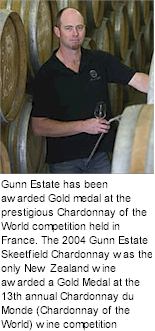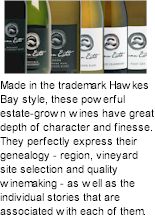


Since these first plantings Gunn Estate has grown into a highly regarded producer of quality New Zealand wines including Sauvignon Blanc, Chardonnay, Riesling and Bordeaux varietals including Merlot, Cabernet Sauvignon and Malbec. The textured symbol on the Gunn Estate logo represents the Greywacke river gravel and waters of the Ngaruroro river that follow near the estate vineyards, it also symbolises the ‘O’ of Ohiti Valley - home of the Gunn Estate family. ‘From the Heart, from the Home’, captures the essence and philosophy of the Gunn family who have tilled and nurtured the estate vineyards since the mid 1980’s.

Gunn Estate spreads along the northern banks of the Ngaruroro River at the foot of the Ohiti Valley. Just across the river is the Gimblett Gravels sub region, and Gunn Estate shares many of the terroir characteristics that have built a huge international reputation for this small slice of Hawkes Bay. In 1920, when George (Poppa) Gunn arrived here from Roxburgh in Central Otago, this was a farming region where great skill and experience were required to compensate for the poor soils and rather dry conditions. For more than 60 years, the Gunn family poured hard work and determination into the mostly unreceptive ground.
During the early 1980s, Alan Gunn - George Gunn's eldest grandson - suggested that the familys land had the potential to become one of the countrys finest vineyards. Forward thinkers had just begun to grow classic varietal grapes in the Hawkes Bay, so his hunch was not without foundation.
With their wine growing reputation improving with every year, Alan and younger brother Denis turned their attention to the development of their own wine label - a brand that would express the essence of the Ohiti Valley area. Their dream became a reality in 1994, when the first wine was released under the Gunn Estate name - an unoaked chardonnay.

Today, Gunn Estate produces a range of wines - some from carefully selected vineyards around New Zealand, others from the winery's spiritual home, the Ohiti Valley. All Gunn Estate wines reflect the passion and determination of the three generations of Gunns who have lived, loved and worked their estate since 1920.
You’d think the Ohiti Valley was purpose built for wine making. The valley’s sedimentary soils are the result of thousands of years of river flooding, which allowed greywacke river gravels to be deposited on the plains.
These soils are wine-friendly because they hold heat, drain freely and inhibit the vigour of the vines, which helps to concentrate flavours in the grapes. What’s more, the site of Gunn Estate’s Ohiti Valley vineyards is protected from the prevailing north west winds by the surrounding limestone hills, creating an unusually warm microclimate that provides optimum ripening conditions.

























